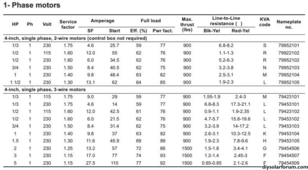yyzhulk
New Member
Hi all, I'm researching information so I can setup a solar charged, battery backup solution for my well. It seems that we get hit with at least 1 power outage per year and aside from our refrigerator, water is the biggest issue. These outages seem to last anywhere from 3 - 10 hours. I was hoping someone could help me estimate the start and run wattage. I find conflicting info on the required wattage and I would appreciate any help you can provide. Here is my configuration info:
Well pump type: Submersible
Well Depth: 462 Ft
Static Water level: 367 FT
GPM: 17 (1 hour test last year)
The Well is on it's own meter. Below the meter there is a box with 30 Amp breaker. Then below that is a 3 HP Franklin Electric Water Pump Control box (2823028110).
According to the control box it is:
3 HP
230 V
Single Phase
AMP 14.5
S.F. Max. Amp 17
KW 2.2
RPM 3450
The pressure switch runs for about 1 minute intermittently based on water usage at 30-50 PSI. If start and run capacitor numbers are helpful, I can provide those also.
Thank you for any help you can provide!
Well pump type: Submersible
Well Depth: 462 Ft
Static Water level: 367 FT
GPM: 17 (1 hour test last year)
The Well is on it's own meter. Below the meter there is a box with 30 Amp breaker. Then below that is a 3 HP Franklin Electric Water Pump Control box (2823028110).
According to the control box it is:
3 HP
230 V
Single Phase
AMP 14.5
S.F. Max. Amp 17
KW 2.2
RPM 3450
The pressure switch runs for about 1 minute intermittently based on water usage at 30-50 PSI. If start and run capacitor numbers are helpful, I can provide those also.
Thank you for any help you can provide!



